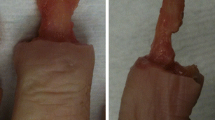Abstract
The aim of the current study was to test a protocol of quantification of phalangeal three-dimensional (3D) rotations during flexion of three-joint digits. Three-dimensional-specific software was developed to analyze CT reconstruction images. A protocol was carried out with six fresh-frozen upper limbs from human cadavers free from any visible pathology (three females, three males). CT millimetric slices were done for reconstruction of hand bone units. Orthonormal coordinate systems of inertia were calculated for each unit. Three-dimensional phalangeal rotations were estimated between two static positions (fingers in extension and in a fist position). Results were displayed for the joints of each three-joint finger with calculation of 3D rotations. Mean longitudinal axial rotations of metacarpophalangeal (MCP), proximal interphalangeal (PIP) and distal interphalangeal (DIP) joints ranged from 14° pronation to 19° supination. The index finger was in a global pronation position (4/6 specimens). The fourth and fifth fingers were in a global supination position in every case. The third finger was in a more variable global rotation (pronation in 2/6 specimens). MCP, PIP and DIP flexion angles ranged respectively from 71° to 89°, 65° to 87°, and 41° to 77°. Lateral angles ranged from 19° (ulnar angulation) to 23° (radial angulation). The study of phalangeal rotations was possible in spite of a heavy protocol. This protocol could be partially automatated to speed up the analyses. Longitudinal axial rotations could be analyzed, in addition to flexion/extension or abduction/adduction rotations. CT scan reconstructions would be helpful for investigating pathological fingers. Abnormal rotations of digits could be quantified more precisely than during a current clinical examination of the hand.





Similar content being viewed by others
References
Brooks N, Mizrahi J, Shoram M, Dayan J (1995) A biomechanical model of index finger dynamics. Med Eng Phys 17:54–63
Chiu HY, Lin SC, Su FC, Wang ST, Hsu HY (2000) The use of the motion analysis system for evaluation of loss of movement in the finger. J Hand Surg [Br] 25:195–199
Craig SM (1992) Anatomy of the joints of the fingers. Hand Clin 8:693–700
Crisco JJ, Wolfe SW, Neu CP, Pike S (2001) Advances in the in vivo measurement of normal and abnormal carpal kinematics. Orthop Clin North Am 32:219–231
Crisco JJ, McGovern RD (1998) Efficient calculation of mass moments of inertia for segmented homogeneous three-dimensional objects. J Biomech 31:97–101
Degeorges R, Oberlin C (2003) Measurement of three-joint-finger motions: reality or fancy? A three-dimensional anatomical approach. Surg Radiol Anat 25:105–112
Dubousset JF (1980) Les articulations des doigts. In Tubiana R (ed) Traité de chirurgie de la main, vol I. Masson, Paris, pp 227–233
Dubousset JF (1980) Les phénomènes de rotation axiale lors de la prise au niveau des doigts. In: Tubiana R (ed) Traité de chirurgie de la main, vol I. Masson, Paris, pp 238–242
Ehara Y, Miyazaki S, Tanaka S, Yamamoto S (1995) Comparison of the performance of 3D camera systems. Gait Posture 3:166–169
Ehara Y, Miyazaki S, Mochimaru M, Tanaka S, Yamamoto S (1997) Comparison of the performance of 3D camera systems: II. Gait Posture 5:251–255
El-Shennawy M, Nakamura K, Patterson RM, Viegas SF (2001) Three-dimensional kinematic analysis of the second through fifth carpometacarpal joints. J Hand Surg [Am] 26:1030–1035
Faraway JJ, Zhang X, Caffin DB (1999) Rectifying postures reconstructed from joint angles to meet constraints. J Biomech 32:733–736
Miura T, Matsumoto T, Nishino M, Kaneuji A, Sugimori T, Tomita K (1998) A new technique for morphologic measurement of the femur. Its application for Japanese patients with osteoarthrosis of the hip. Bull Hosp Jt Dis 57:202–207
Orset G, Lebreton E, Assouline A, Giordano P, Denis F, Pomel G (1991) The axial orientation of the phalanges following the curling up of the fingers. Ann Chir Main 10:101–107
Schultz RJ, Storace A, Krishnamurthy S (1987) Metacarpophalangeal joint motion and the role of the collateral ligaments. Int Orthop 11:149–155
Small CF, Bryant JT (1993) Optimized 3D coordinate reconstruction from paired stereographs using a calibrated phantom. J Biomed Eng 15:163–166
Tagare HD, Elder KW, Stoner DM (1993) Location and geometric description of carpal bones in CT image. Ann Biomed Eng 21:715–726
Wolfe SW, Neu C, Crisco JJ (2000) In vivo scaphoid, lunate, and capitate kinematics in flexion and in extension. J Hand Surg [Am] 25:860–869
Acknowledgments
We thank Prof. Lassau, Prof. Oberlin and the Anatomy Institute (Saints-Pères, Paris).
Author information
Authors and Affiliations
Corresponding author
Rights and permissions
About this article
Cite this article
Degeorges, R., Laporte, S., Pessis, E. et al. Rotations of three-joint fingers: a radiological study. Surg Radiol Anat 26, 392–398 (2004). https://doi.org/10.1007/s00276-004-0244-0
Received:
Accepted:
Published:
Issue Date:
DOI: https://doi.org/10.1007/s00276-004-0244-0




